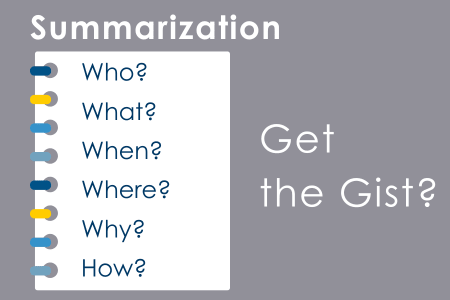Summarization requires students to identify main ideas, synthesize information, and craft concise statements. Whether reading a single paragraph, book chapter, informational text, or current event article, summarization is a powerful tool for grasping main ideas. Given the focused engagement with a text that summarization requires, it is not surprising that summarization has been identified in research as a primary strategy for improving reading comprehension (National Institute of Child Health and Human Development, 2000; Biancarosa & Snow, 2006).
The 5 W’s and H
The 5 W’s and H (Who, What, When, Where, Why, and How) are fundamental to the summarization process. They were highlighted over a hundred years ago in a book for journalists as essential prompts for writing engaging leads that “give the reader in clear, concise, yet interesting form the gist of the whole story” (Bleyer, 1913, p. 66) Over a hundred years later, they have not lost their relevance or power. Using the 5 W’s and H helps students clarify main ideas by narrowing content to the most essential people, things, actions, and events; the primary reasoning and processes that underly those actions and events; and important contextualizing details such as time and place. They can be used to create after-reading summary sentences across content areas and text types, and they can be used in scaffolded sentence expansion activities in which one or more question words are used to transform an unelaborated sentence into a more detailed, linguistically rich one. Since they can be introduced to very young children through oral language prompts and adapt seamlessly to increasingly complex material, they are the foundation of effective summarization throughout the grades.

Gist Statements
Gist statements are a during-reading strategy for summarizing single paragraphs and short passages of text. Passages can be lengthened over time as students become more proficient in the strategy. The gist routine consists of three parts: identifying the who or what the section is about, identifying the most important information about the who or what, and combining this information to write a concise summary sentence or main idea statement. Teachers may opt to provide a word limit for the gist statement, which can vary depending on grade (The Meadows Center for Preventing Educational Risk, 2010).

Stevens and Vaughn (2021) suggest using text structure as a “fix up” strategy when students have difficulty sifting through extraneous information to identify the most important information about the who or what of a passage. Question prompts specific to different text structures can be used to help students refine their thinking. Signal words such as but, because, so, although, and since can be incorporated into gist statements to make them more precise.

Instructional Considerations for Teachers
- Teach summarizing in the context of authentic reading and writing experiences.
- Utilize an explicit instruction model with gradual release of responsibility.
- Plan ahead. Create teacher copies of summary sentences and gist statements.
- Project the passage on an interactive whiteboard to allow for multisensory support and the visual demonstration of circling, underlining or highlighting key words and phrases.
- Model steps with think alouds, demonstrations, and board notes.
- Provide corrective feedback during guided practice.
- Work toward increased independence as skills develop.
References
Biancarosa, C., & Snow, C. E. (2006). Reading next – A vision for action and research in middle
and high school literacy: A report to Carnegie Corporation of New York (2nd ed.). Washington,
DC: Alliance for Excellent Education.
Bleyer, W. G. (1913). Newspaper writing and editing. Project Gutenberg. Retrieved from:
https://www.gutenberg.org/cache/epub/65884/pg65884-images.html#Page_60
National Reading Panel (U.S.) & National Institute of Child Health and Human Development (U.S.).
(2000). Report of the National Reading Panel: Teaching children to read : an evidence-based
assessment of the scientific research literature on reading and its implications for reading
instruction. U.S. Dept. of Health and Human Services, Public Health Service, National Institutes
of Health, National Institute of Child Health and Human Development.
Stevens, E. A., & Vaughn, S. (2020). Using paraphrasing and text structure instruction to support
main idea generation. Teaching Exceptional Children. Advance online publication.
https://journals.sagepub.com/doi/pdf/10.1177/0040059920958738
The Meadows Center for Preventing Educational Risk. (2010). Vocabulary and comprehension:
Effective upper-elementary interventions for students with reading rifficulties. The University of
Texas at Austin. https://meadowscenter.org/resource/vocabulary-and-comprehension-effective-
upper-elementary-interventions-for-students-with-reading-difficulties/
Vaughn, S., Kieffer, M.J., McKeown, M., Reed, D.K., Sanchez, M., St. Martin, K., & Wexler, J.
(2022). Providing reading interventions for students in grades 4-9 [Educator’s practice guide].
National Center for Education Evaluation, Institute of Education Sciences, What Works
Clearinghouse (WWC 2022007), U.S. Department of Education.










